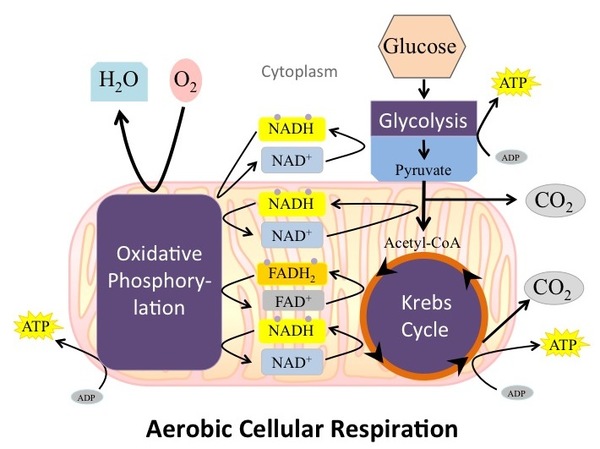| << Chapter < Page | Chapter >> Page > |
Some single-celled organisms use anaerobic metabolism to extract energy from biological molecules; this process occurs in the absence of oxygen. In this chapter, we will explore one type of anaerobic metabolism called fermentation. You may already be familiar with a one type of fermentation, lactic acid fermentation, especially if you have recently over-exerted your muscles. Anaerobic metabolism is used by many organisms to produce ATP when oxygen is not available and thus pathways which require oxygen cannot be used. The amount of ATP produced by fermentation is much less then that produced by aerobic cellular respiration, so there is a cost and benefit associated with organisms utilizing fermentation.
Aerobic cellular respiration (
[link] ) is series of linked chemical reactions that can be best understood if it is separated into four stages. These are
glycolysis , pyruvate oxidation, the
Krebs Cycle , and
oxidative phosphorylation . Similar to photosynthesis, cellular respiration uses a series of oxidation-reduction reactions. During these reactions, electrons are stripped from the chemical bonds of the original glucose molecule and eventually added to oxygen, via a series of intermediate steps. This series of reactions releases small amounts of energy at each step; this energy is used to drive the formation of ATP. This section is a brief introduction to the stages of aerobic respiration with more detail to follow in the chapter.

The first stage of cellular respiration is called Glycolysis and occurs in the cytoplasm of the cell. During glycolysis, 1 glucose molecule (with 6 carbon atoms) is broken down into 2 pyruvate molecules (with three carbon atoms each). This is accompanied by the production of a few ATP molecules and the storage of some high-energy electrons on the electron carrier NADH. Note that no O 2 is needed for this set of reactions, which means that glycolysis can proceed in the absence of oxygen.
The second stage is a short series of reactions called the oxidation of pyruvate during which pyruvate (3 carbon atoms) is converted to acetyl-CoA (two carbon atoms), accompanied by the production of CO 2 (one carbon atom). This process occurs on the mitochondrial inner membrane, and as a result the acetyl-CoA is formed inside the mitochondria. Pyruvate is made in the cytoplasm, and this step moves the next compound in the pathway into the mitochodria. This is critical, since all subsequent steps in the pathway occur within the mitochondria. The other important event of this stage is the addition of high-energy electrons to NAD + , generating another molecule of the electron carrier NADH.
Acetyl-CoA enters into the Krebs cycle , a series of mitochondrial reactions that completes the breakdown of the original glucose, thereby releasing CO 2 . In this third stage of the process, energy is harvested in the form of high-energy electrons being used to generate NADH as well as another high-energy electron carrier, FADH 2 . The reactions of the Krebs cycle also produce a small amount of ATP.
So far, a minimal amount of ATP has been produced, but a lot of energy has been stored in the electron carriers NADH and FADH 2 . In the final stage of aerobic cellular respiration, Oxidative Phosphorylation , a series of enzymes known as the electron transport chain uses those high-energy electrons to produce a large amount of ATP. The high energy electrons harvested in the first three stages, and ferried by electron carriers (NADH and FADH 2 ) to the electron transport chain, are used to produce large amounts of ATP vir the mitochondrial membrane protein known as the ATP synthase . During this final stage is also when atmospheric oxygen is used as the final electron and hydrogen ion acceptor, in a reaction which produces water. The need for O 2 in this final step means that these reactions are part of aerobic cellular respiration.
All eukaryotic cells (protists, fungi, plants and animals) have mitochondria, and mitochondria are often called the power plants of the cell because these organelles produce a large amount of ATP. As you may remember from a previous module, the mitochondrion is an organelle that is hypothesized to have originated as an endosymbiotic aerobic bacteria. Some of the evidence for this hypothesis comes from the relationship of the functional parts of the mitochondria (
[link] ) to the structure of a typical aerobic bacteria. There is an
outer membrane which defines the organelle and represents the membrane which enveloped the bacteria when it was taken into the cell via endocytosis. The inner membrane represents the plasma membrane of the bacteria; the inner and outer membranes together form the
intermembrane space . The
inner membrane is highly folded; these folds are called
cristae . The extensive folding increases the surface area for the numerous electron transport chain enzymes and the ATP synthases that are used to make ATP. In bacteria all of these enzymes are packed into the plasma membrane, as one would expect if the endosymbiotic hypothesis is correct. The production of ATP is driven by a concentration gradient between the outer and inner compartment; in aerobic bacteria this concentration gradient is between the inside and the outside of the cell. The innermost compartment, derived from the cytoplasm of the ancestral bacteria, is called the
matrix , and this compartment (just like the cytoplasm of today's bacteria) contains ribosomes and DNA; It is also the location of the Krebs Cycle reactions.


Notification Switch
Would you like to follow the 'Principles of biology' conversation and receive update notifications?